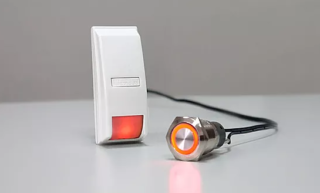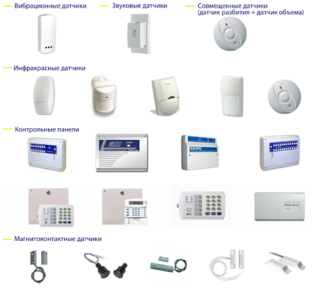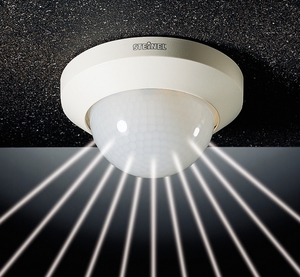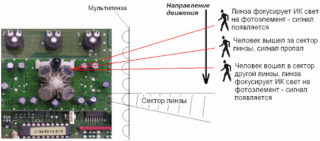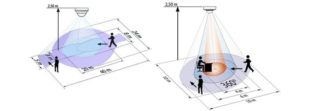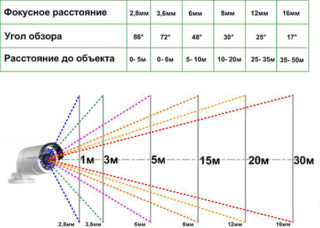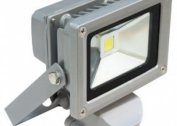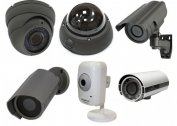Motion detectors are used in the field of security and private automation systems. The presence sensor belongs to a more sensitive group of devices, it detects small movements in the controlled area. The node signals a change in situation, generates a command to automatically start the response to the movement of objects.
The principle of operation of the presence sensor
The device monitors the degree of infrared radiation in the field of view. The level is averaged and perceived as a monotonous plan. The background temperature rises during the presence of a person, a pyroelectric detector creates a voltage to supply a signal.
It is based on an optical scheme based on the Fresnel lens principle; sometimes a set of concave mirrors of a segment type is used. The areas focus the heat rays on the pulse producing element. When moving an object, IR rays pick up and emit bursts. The presence sensor delivers the final detection signal after the accumulation of 2 to 4 pulses, the number depends on the sensitivity of the device.
Features and characteristics of the device
The sensor works in conjunction with other modules that are triggered by its signal. Security system devices are controlled by the controller, which is placed in the circuit during installation.
Security devices perform actions based on the presence detector signal:
- give an alarm to the control panel;
- send notifications of violation of borders to the owner of the premises, territory;
- turn on and off lighting, control other devices;
- change the functionality of climate modules, technology.
Smart switches, sirens, meters, monitors start working when the virtual presence detector detects movement. Manufacturers give access to an account on a web portal where a user uses a mobile program to configure interaction and set parameters.
Varieties of presence sensors
Optical varieties operate on the principle of blocking a light beam by an opaque object and determine the size of the body. These include laser rangefinders. Ultrasonic types conduct the location of space with ultrasound and find the distance to a moving object.
Microwave sensors apply the principle of microwave waves to pass through objects or reflect off certain surfaces. Used in systems that control the area behind a wall that is permeable to beams.
Magnetosensitive devices are placed as non-contact type switches. They include a Hall sensor and an electromechanical switch; they are mounted in a window and door opening circuit. Pyrometric devices use a level of infrared rays and work to determine movement.
To turn on the light
Motor detectors start lighting only when people are active, for example, if a person is walking in range. A more sensitive presence sensor for turning on the light is different in that it responds to small movements. It records the movement of the hands, fingers, tilts of the head. The device will turn off the lighting if a person sits without movement for a specified time.
Devices turn on the light if people move in the dark, but do not work during the day when everything is visible. At night, the sensors provide lamp operation before the last person leaves the coverage area.
IR sensors
Instruments study the change in infrared rays reflected from surrounding objects. Passive sensors only perceive heat waves, and active species themselves emit vibrations and await a return return for analysis.
Thermal rays represent spectral radiation that is not distinguished by the eye, but is detected by the photoelectric sensors of the sensor. The body of a person or animal does not shine in the visible range, but shines in the infrared spectrum. Presence devices respond to the occurrence or disappearance of radiation. The sensitivity of the modules is adjusted so that they respond only to large objects and do not notice birds and small animals.
Human presence sensors
The operating parameters are set so that the control degree is higher than the level of acoustic, infrared and thermal noise.
Sensors are:
- single-position, when radiation, signal reception and analysis occurs in one device;
- on-off, if one unit emits waves, and the other receives and studies;
- multi-position with a large number of nodes for a more accurate response.
The tracking module gives a signal to send a notification of penetration to the owner. The alarm comes in the form of a message on the phone in the selected form. You can specify multiple numbers for alerts.
Areas of use
In rooms with tracking detectors, energy is saved by 40%, and costs are reduced by 50 - 60%. The device turns on the air conditioner when there are people, and also coordinates the lighting and stops it when a person is absent.
Devices are mounted in the form of local elements, window opening coordinators, and are used in the “smart home” system. Design models are placed in the private sector, street appliances regulate the light in the hallways, courtyards. Presence sensors monitor the situation in warehouses, production halls and offices. Devices provide safety in separate rooms or in the whole building.
Difference from motion sensor
The basis of the work are the same mechanisms. The motion detector has dozens of microlenses, the space is divided into the same number of parts for research. The presence detector contains hundreds of such reflectors that coordinate the smallest areas and track small amplitude movements.
Instruments for determining the presence of a person are configured much more painstakingly. Due to their high sensitivity, they often give a false alarm. An electronic embedded processor is used to reduce such incidents, and manual setup is not used.
Rules for choosing a presence detector
The choice is affected by the installation location, available power options, and the amount of coordinated space. For indoor use, a device with appropriate characteristics is selected, for example, without surges in temperature, dust and humidity. Outdoor devices have enhanced weather protection and extended reach.
When selecting characteristics are taken into account:
- type of appliance;
- working power;
- powered by mains or batteries;
- coverage angle and tracking range.
Pay attention to additional features of the model. It provides protection against false alarms when small warm-blooded objects appear, a delay in turning on the light during movement, and protection from turning on the lamps during the day.
Presence Sensor Installation
The device is placed so that direct light beams do not fall on it, and objects that obstruct the view do not stand nearby. Glass partitions are undesirable on the wave path, because IR rays do not pass through the material. The corners of the room should fall into the radius of coverage, otherwise several devices are installed, and this results in overlapping areas of attention.
Tracking detectors are not placed near heating radiators, air conditioners, or paddle fans. On the street, the devices are mounted under a canopy, taking into account the recommended installation height, which is given in the passport.
DIY making
Self-assembly is an alternative to a factory device if the parameters are not suitable. The design uses inexpensive elements, and for an increased load, 2 relays are set.
Parts required:
- Power Supply;
- pnp junction transistor;
- resistor;
- relay;
- photocell.
A low-voltage (5 - 12 V) unit is used in accordance with the load, for example, the number of lamps. A current limiting resistance is connected to the anode of the photocell, and a positive power pole is soldered to the cathode. One output of the resistor is connected to the minus, and the other is connected to the limiting resistance.
Scheme
Photocells for receiving waves are placed in the middle of the detector. The elements are closed by a common lens, which contains many small lenses to concentrate the infrared rays before applying to the reflectors. When moving, the focus shifts from the element and disappears on one glass, but is shown on another. The sensor is triggered after several similar disappearances and appearances.
The device contains a wave generator, amplifier and compressor. After the return reception, the frequency shift is measured, and the speed of movement is found. The capacitor in the circuit equalizes the frequency with the resonant index of the antenna. The sensor is assembled on a board of fiberglass material and closed by a housing, the antenna goes outside.
